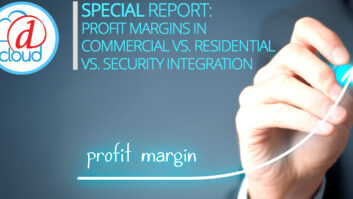The “third rail” of the consumer electronics and custom integration industry–a subject so hot that you’ll get burned if you touch it– is the topic of profits. Profits are something we all have (hopefully) and something we all want more of, whether you are an integrator, distributor, or manufacturer. But many in the industry have pointed to a long-term compression of realizable profit margins as one of their most vexing problems. Does margin compression exist, or is it an illusion? And if it does exist, who is to blame? Perhaps most importantly, what should we do about it?

If you take the time to talk to the two sides of the issue of industry profitability– in one case, a group of integrators, and in the other, case a group of manufacturers– you get widely varying opinions as to just what the root factors are that contribute to margin compression. But there’s one thing that almost everyone agrees upon: it’s the other sides’ fault.
Integrators: Here’s Looking at You, Manufacturers
Most integrators interviewed for this article were quick to agree that there is an ongoing margin compression problem, and many pointed to industry product development trends as the fundamental cause.
“You know video is the biggest [culprit],” said Marty Hayse, director of sales and purchasing for Phoenix, AZ-based Dennis Sage Home Entertainment. “And even the new categories…I mean, how long did we enjoy real profitability with 4K? And they’re already compressing the crap out of that. You know video–that’s a different animal.”
Video, however, is not the only culprit. The seeds of industry-wide margin compression were sowed long ago, with the advent of the switch from analog to digital products.


Marty Hayse, director of sales and purchasing, Dennis Sage Home EntertainmentSteve Firszt, president, Vital Management
“Yes, there is price and margin compression that comes from digital products,” said Steve Firszt, president of Vital Management, a management consulting company that specializes in the custom integration channel. “That’s been going on since the mid-1980s when the CD player was first invented by Sony. I remember when Sony later rolled out their first CD changer and the price point was like $300, which was already too cheap. And then, suddenly, it was $199 and I was just bitching and moaning about it. Well, look, that’s how digital evolves, right? Digital products just go that way, so you have to get a good mix of analog into your business.”
In addition to digital products, custom integration is now heavily influenced by the IT industry in the form of networking gear. Just about all installations today are dependent on a relatively sophisticated home network backbone. The problem is that the IT industry is built on a different business structure, relying generally on low margins/high volume.
“I think that networking for the common guy, that’s compressing a little bit,” Hayse suggested, referring to networking products designed for midlevel system installations.
Integrators were split, however, on the issue of “the Sonos influence” on margin erosion. Some suggested that the wireless audio king offered very poor margins to integrators and therefore, since it’s so popular, is contributing to an overall margin decline. But others believed Sonos was both easy to sell and easy to upgrade, and therefore was less of an issue.
Over-Distribution and Internet Sales
Some integrators suggested that more suppliers are tending to over-distribute their products. There is a myth, they say, of suppliers believing that integrators do not compete with each other on brands in the same manner that retailers do. This mistaken belief causes manufacturers to sell multiple integrators in a given market, often including small, one- or two-man operations commonly referred to as “trunk slammers” in the industry.
But most integrators point to the destabilizing influence of the internet and online e-tailers, as significant factors driving industry margin compression. Consumers are becoming more and more technology savvy, and it is easier than ever to pull out a smartphone, punch a model number into a search engine, and scour the globe for the lowest price available.
In addition to all of the above, consider the growing trend in the industry of manufacturers authorizing online e-tailers like Amazon.com and others to sell their products, and integrators suddenly find themselves in competition with low-overhead online operations that have lower margin requirements as they drive a high-volume business.
Commenting on whether manufacturers selling products online poses a threat, Dennis Sage’s Hayse said, “Absolutely. Amazon is a huge threat.”
Integrators say they find themselves sandwiched between the higher costs/lower margins of certain emerging product categories impacting their buy-side, and the lower realizable sales prices, thanks to the internet or local competitive environments, impacting their sell-side.
Manufacturers: Integrators Should Look in the Mirror
Wait a minute, manufacturers say, integrators should take a good long look in the mirror before they pin the cause of margin compression on brands. Often, they say, integrators are looking to have their cake…and eat it too. But many integrators are running inefficient organizations that needlessly squander margin and then expect manufacturers to bail them out.
“I had one customer who called me upset because his shipping charges totaled more than the product cost,” said Larry Smith, national sales manager of Wireworld Cable. “But I didn’t tell him to wait until the last minute and then order his cable shipped red label.”

Larry Smith, national sales manager, Wireworld Cable
Manufacturers actually related several stories of this nature. None of them question the complexity of juggling several parallel installations, but most are annoyed that the integrator expects the manufacturer to help them out by providing an unrealistically large margin to make up for their own internal inefficiencies.
Firszt seems to agree that manufacturers have a point: “There are two reasons for the perception that integrators always talk about. One is the reality of digital price and margin compression. And the other one is the marketplace is dominated by these companies that don’t know what they’re doing. They do not run their businesses effectively because they’re run by technicians instead of business managers. Is that real? It’s so real it’s ridiculous. Those guys don’t know what their real costs are.
“And so the lack of professional management in this business results in a plethora of companies going out there and desperately bidding for business without any real handle on whether this is a profitable proposal or not.”
Almost all the manufacturers interviewed acknowledged that they are constantly asked to expand margins. And it didn’t seem to matter if they were high end, or more mainstream brands.
“Yes, always we would have dealers–and, today, home technology professionals–asking for better margin, better margin, better margin,” said Vin Bruno, CEO of CEDIA, commenting from his experience as a former corporate executive at Crestron. “And I find that many of those folks were too focused on the product.”


Vin Bruno, CEO, CEDIACharlie Porritt, CEO, Russound
“Yes, absolutely,” said Charlie Porritt, CEO of New Hampshire-based Russound, also acknowledging that he regularly hears integrators asking for more margin. “That’s one of the reasons we created our RCI [Russound Certified Installer] program.”
Many manufacturers said that they believe that integrators need to learn how to sell premium products for a premium price.
“I believe the integrator sells themselves short by saying ‘Hey, I’ll take the short margin’ and not really sell anything of value,” Porritt said. “So they don’t know how to sell premium products, or they might know how to do it, but they don’t have the bandwidth.”
Integrators Say the Solution is Easy
Not only do integrators regularly request that manufacturers increase product margins, but many naively suggest that this is an easy task. If the manufacturer can’t lower its cost on an item while maintaining the suggested retail price, then it should simply raise its retail price point, they argue. But manufacturers say it isn’t that easy.
“The dynamic today, which is really, really hard for manufacturers, is that you’ve got distributors– and their margin–who sell to the [integrators and dealers],” said CEDIA’s Bruno. “And then you’ve got buying groups, and the cut they’ve got to get. All of a sudden, the pricing schedule has become very complicated. It’s gotten so complicated that you cannot focus on the margin on any one particular product. And these home technology professionals and dealers that are putting that burden on a manufacturer; that’s misplaced.”
Russound’s Porritt agrees. “There are so many steps to the process. Look at my food chain: I’ve got manufacturing, I’ve got my own markup, I’ve got the distributor’s markup, [I’ve got] the integrator’s markup. And, of course, everybody says, ‘I need to make X margin.’”
Manufacturers say that integrators need to understand that the costs they incur to design, engineer, manufacture, and distribute products are not declining. In fact, they continue to grow over time.
“You know the labor rates in China continue to do nothing but skyrocket,” Porritt said emphatically. “You know they’re double digits growth–anywhere from 10 percent to 30 percent wage increases year-over-year. So how do you cut the cost out? Does the manufacturer make less money? Does the integrator make less money?”
Porritt also said that raising margins is not simply a matter of artificially increasing the retail price. “You’ve got integrators that say, ‘Well you’re priced too high, so I’m just going to take the easy route and sell a Sonos system,’ he noted. “But, from my viewpoint, what integrators are missing the ball on is not only the margin aspect [less margin earned on Sonos], but what I’m selling you is built into your house and fits your lifestyle. It’s not a toaster sitting on your kitchen table or nightstand or any of that other stuff. The speakers are installed and can be invisible, but you still have the great music.”
What To Do About Margin Compression?
So margin compression–whether real or imagined– is a serious problem for the industry. On this point, there was wide consensus among those interviewed.
“For our industry to survive, we need profitability,” Porritt said. “We need our goods to have some sense of value. You know we can’t follow [the] trend of the video business. I mean, look what the video business did: they’ve taken it down to– what are there–Samsung and LG left? They did it [to] themselves.”
In 2015, Russound looked to take steps to protect the integrator channel by launching its Russound Certified Installer program (RCI). With RCI, Russound products are sold locked and inoperable, requiring a special code to activate the unit. Only properly trained and certified Russound installers have the correct codes to activate Russound products.
Although it costs the company a fairly significant amount of money to put such a system in each of its products, Porritt said RCI virtually eliminates the problem of unauthorized sellers, helping to protect a more profitable margin for the integrator.
CEDIA Sees Opportunity for Profit
Helping integrators succeed and be more profitable is a key function of CEDIA as well, and Bruno was quick to offer suggestions.
“So today, what home technology professionals need to focus on is the solution–what is the value proposition to the client–not so much the widget. Anybody who is selling on a product, they’re the ones that aren’t surviving. They’re the ones going out of business. The guys that sell on the value of what we do, the whole-home solution, they’re doing well.”
CEDIA provides an extensive catalog of training classes and educational material, all specifically designed to help integrators improve their operations, and ultimately, their profits.
“Here’s what the home technology professionals don’t understand: their greatest asset is themselves– their time and their knowledge,” Bruno said. “And they don’t put a price on that. That’s where they should be making their greatest margin.”
This past May, CEDIA put on a Business Xchange event that primarily focused on employment issues, and it was quite successful, according to Bruno. The organization is planning to offer another Business Xchange event March 1-3 in San Antonio that will focus on sales and marketing issues, an area on which he believes many integrators need training.
“These guys are afraid to give clients a [profitable] price,” Bruno said. “You know what the client wants? The client wants an exceptional experience. They want to be covered–when [the installed system] is not going to work, they want to call and you’re going to fix it right away.”
As others suggested, Bruno said clients do not come to their local custom integrator solely for the purpose of buying products at the cheapest price. Clients come to integrators for an “exceptional experience.”
Focus More on The Value Proposition
Vital Management’s Firszt feels that industry-wide margin compression isn’t a significant factor in integrator profitability.
“I think I probably look at more dealer financials on a regular basis–and have looked at more–than many other people in the industry,” he said. “I have seen no decline in the realizable margins since I started doing this 12 years ago.”
Yes, digital products exhibited compressed margins, but these issues are relatively minor, he suggested. Dealers always find something to complain about. “It’s only been going on since 1974,” Firszt laughed.
“I have seen the enemy and the enemy is us,” Firszt said with a chuckle. A former Illinois specialty retailer who became an integrator, Firszt said dealers need to focus more on what they are doing and stop looking for someone to blame. For example, he has heard a lot of integrators complain about trunk slammers–installers with no central facility who work out of the trunk of their cars. What does he tell them?
“Your value proposition has to be more enticing than theirs,” he said with determination. “And if the value proposition is just the price, well then, lose the customer anyway, because that’s just a pain in the ass.”
Integrators need to understand their customer– and their role. “Retailers merchandise price points…integrators merchandise solutions,” Firszt added.
“The value proposition isn’t in the box, the value proposition is much more in the integrator than it is in the box,” Firszt said. “And the value-proposition picture has to be painted by the integrator for the client, cause the client typically doesn’t see it, but they know you’re more expensive. That’s the funny thing: the customers already knows we’re expensive. They did not come to us for the best deal. They came to us because we’ve got something the other guys don’t. The price of the solution is what it is.”
Dennis Sage Home Entertainment has taken a very proactive approach to staving off margin compression, according to Hayse. The key is to tighten the bonds with a short selection of your key brands. Work closely with them and you can create what Hayse called “profit below the line of scrimmage.”
“You work with the vendors. You become very vertical with as few vendors as you can–and then you go leverage that,” Hayse said. “Buy from as few as you can. Buy as much as you can…and negotiate the hell out of the relationship.”
With this strategy, the integrator can show growth to these vendors and negotiate rebates that beef up the bottom line. The result is a win-win partnership with vendors that can make a huge impact on your company’s profits. And presented properly, such offers are virtually irresistible to vendors.
Yet another strategy for the integrator is to join one of the major buying groups.
“And then there’s kind of the hybrid stuff, which is working with buying groups and taking advantage of some of their leverage,” Hayse said. “You know we’re a ProSource member, so taking advantage of some of those deals [adds to profits]. And then going and getting a backside two or three or four here…and a backside two or three or four there.”
From these combined initiatives, Dennis Sage has not only gleaned added margin, but deeper relationships with those vendors it bends over backwards to support. Hayse said these deeper relationships offer other benefits that are both helpful and profitable, such as when a defective product is immediately credited, no questions asked.
“They have the money. You just have to tell them how you’re going to use it and make it worth their while, and let them know they’re putting their money to good use,” Hayse said. “I think that’s where the average integrator doesn’t understand the power of negotiation. There’s money there if they know that you know what you’re doing.”
How to grow your profits in an era of declining margins? Firszt summed it up:
“There’s only three strategies for making more money: raise your revenues, raise your prices, or lower your costs. Those are the only three: sell more, charge more, pay less–that’s it,” he said. “So any profit improvement strategy involves one of these three–and usually multiple out of those three strategic lanes. But in most cases, the pricing is the first thing to look at.”
And, Firszt adds: “We’ve really never met anybody who couldn’t raise their prices.”
A regular RS contributor, Ted Green publishes a widely read weekly CE business blog at Stata-gee.com, the online home of The Stratecon Group, his marketing and strategy agency for the tech industry.





